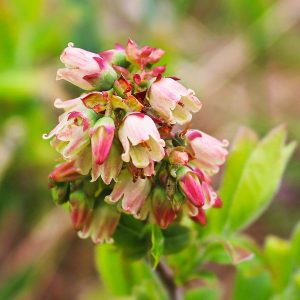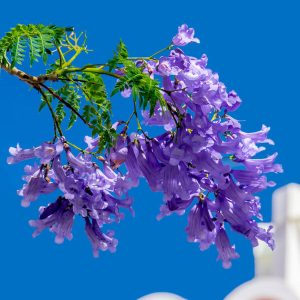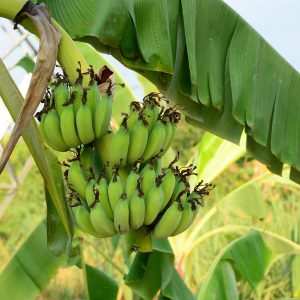What is Dwarf Red Banana Tree
Dwarf Red Banana Offers Mouthwatering Fruit
Esteemed for its excellent fruit, the Dwarf Red banana tree is a bakers’ and cooks’ delight, with very sweet fruit that’s soft, with a custard-like consistency. For growers in zones 8-11 the Dwarf Red banana produces some of the best bananas available.
Create a Tropical Atmosphere
Popular in southern Florida, the tree lends a charming, tropical feel to your garden or landscape. If you have limited space, they make great patio plants – and do well in 2-3 gallon pots. The Dwarf Red Banana Tree has wide leaves that offer great shade. You can create your own private jungle!
A Dependable Producer
You’ll notice the Dwarf Red Banana Tree blooming in mid-summer. It’s always a treat watch its yellow-green bananas grow in and turn redder as it reaches maturity. You’ll get fruit the first year and each summer thereafter.
Delicious Fruit That’s Excellent for Cooking
When Dwarf Red bananas turn dark burgundy, they’ve gained a sweet, full-bodied flavor. You’ll be salivating over unforgettable breakfasts of smoothies, oatmeal, waffles and pancakes. These top-quality bananas are supreme to store-bought bananas and your desserts will taste sweeter than ever.
A Resilient Tree that Grows Very Fast
You’ll be amazed at how quickly the Dwarf Red banana tree can grow in uniformly warm, wet conditions with proper drainage. Feel free to keep it out in the open; it enjoys full sun and its durable leaves and trunk make it resistant to high wind.
If you can offer the Dwarf Red Banana its desired climate, consider yourself lucky!

How to Grow and Care for Dwarf Red Banana Tree
Dwarf Red Banana Tree (Musa sp.) Growing Requirements
| Hardiness zone | 4-11 patio / 8-11 outdoors |
Seasonal Information
Bananas prefer bright light conditions for 12 hours per day if possible. Constant warmth is also very important, with high humidity (above 50%). Night time temperatures of 67oF and daytime temps in the 80’s; with good air circulation is ideal. Maintain humidity in dry environments by misting and placing it on a layer of pebbles or decorative stone in a tray filled with water. The Dwarf Red Banana can be grown in Hardiness Zones 8 and up. Otherwise, grow indoors primarily with visits outdoors when the above temperature regimes can be met.
Location and Exposure
Sun exposure will determine fruit growth and/or foliage color. Provide a full sun position for your banana plants to give them their best fruit production. Grow in a partially shaded area if aiming for decorative foliage that stays a deep, rich green color. Shelter from the wind is recommended.
Soil Preferences
Provide a sandy soil that is rich in organic matter so that drainage is good, but water holding and a consistent supply of nutrients can be achieved. If creating your own mix of soil, use sand, perlite, and compost or manure. Soil pH should be slightly acidic, within the 5-7.0 range. Adjust pH with Sulfur well before planting.
Planting Instructions
In Pots
Bananas have rhizomatous roots that grow from corms. They also can be fast growers, so size your pot accordingly. A minimum of 3X the size of the root ball at planting will eliminate the need for constant re-potting. Firm the soil around the root ball and do not bury the crown of the plant. Plant in a soil mix as prescribed above, and water well for the first few weeks. Do not overwater to the point where the soil becomes waterlogged. They will take up a lot of water and are heavy feeders. Fertilize at planting, preferably with an organic fertilizer.
In the Garden
Recommended spacing in a garden is about 4’ so as to create a stand, or patch of bananas. Plant in sandy, slightly acidic soil as above, with plenty of organic matter. Before winter, mulch heavily and prune the leaves back.
Watering
Provide consistent water and maintain high humidity, but avoid saturation or water logged soil. Water daily, sometimes twice per day in hot, dry climates. Do not let them fully dry out in between waterings.
Fertilization
Organic based fertilizers are best as they will release over time and not leach out because of the constant watering. Young plants want more nitrogen to help them grow fast. Once established, use a fertilizer with high Nitrogen and Potassium, 15:5:30 is a good formula, and fertilize monthly in the spring and summer. Water deeply after applying the fertilizer.
Diseases and Pests
Bananas are not subject to significant disease pests outside the tropics. Root rot will occur in cold, wet soil, and is by far the greatest disease threat to them. Symptoms of overwatering are leaves dying at the edges and turning brown. If the leaves turn yellow, they need more nutrients. Some insects that might attack your banana plant include the banana aphid, banana weevil, and coconut scale; and are all easily repelled with a mild organic insecticide or Neem oil.
Dwarf Red Banana Tree (Musa sp.) Details
| Common name | Dwarf Red Banana Tree |
| Botanical name | Musa sp. |
| Plant type | Fruit Trees, Bushes |
| Hardiness zone | 4-11 patio / 8-11 outdoors |
| Growth rate | Fast |
| Height | 5-7 ft. |
| Width | 4-6 ft. |








